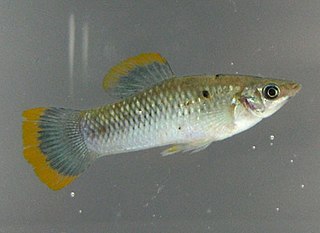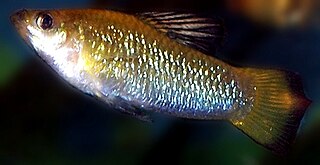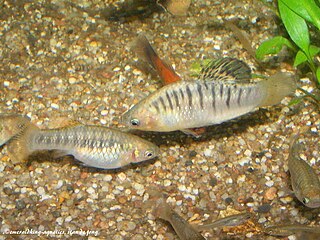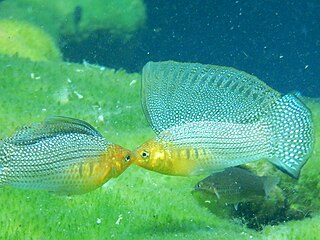
Poecilia is a genus of fishes in the family Poeciliidae of the order Cyprinodontiformes. These livebearers are native to fresh, brackish and salt water in the Americas, and some species in the genus are euryhaline. A few have adapted to living in waters that contain high levels of toxic hydrogen sulfide and a population of P. mexicana lives in caves.

The sailfin molly is a livebearer fish typically found in both freshwater and brackish waterways along the East Coast of the United States, from North Carolina south to Florida, and around the Gulf of Mexico to Texas, and south to the Yucatán Peninsula of México. Given their preference for more brackish water conditions, mollies are often found within just a few yards or miles of the ocean, inhabiting coastal estuaries, lagoons, river deltas and swamps, as well as tidal areas with a regular inflow of oceanic minerals and nutrients mixing with inland freshwater sources.

Poecilia sphenops is a species of fish, of the genus Poecilia, known under the common name molly; to distinguish it from its congeners, it is sometimes called short-finned molly or common molly. They inhabit fresh water streams, coastal brackish, and marine waters from Mexico to Colombia. The wild-type fishes are dull, silvery in color. The molly can produce fertile hybrids with many Poecilia species, most importantly the sailfin molly. The male mollies generally tend to be mildly aggressive.

Limia is a genus of livebearing fishes belonging to the Cyprinodontiform family Poeciliidae, which includes other livebearers such as platys, swordtails, guppies and mollies. They are found in fresh and brackish water. Of the 21 described Limia species, 17 are endemic to Hispaniola, one is found on both Hispaniola and Jamaica, and the Cayman Islands, Cuba, and Venezuela have an endemic species each. Limia are popular in aquaria among more advanced hobbyists.

The Cauca molly is a freshwater fish in the family Poeciliidae. This fish is found in Panama, Venezuela, and Colombia, where it lives in shallow waters in the basins of the Lebrija, Magdalena, Cauca and other rivers. P. caucana eats mosquito larvae and algae.

The humpbacked limia or black-barred limia is a critically endangered species of poeciliid fish which is endemic to Haiti. Its common name is derived from the hump males develop as they age. It is sometimes kept in home aquaria.

Poecilia velifera, known as the Yucatan molly and also as the giant sailfin molly amongst aquarists, is a large livebearer that lives in coastal waters of the Yucatan peninsula. These live-bearer (Poeciliidae) fish are particularly well known for both the extreme size variation among males, and the sexual dimorphism between males and females in both body shape and behavior.

Micropoecilia is a genus of poeciliids native to fresh and brackish water from the Amazon Basin to Trinidad. While recognized as valid by FishBase, others have considered this genus as being synonymous with Poecilia.

Heterandria formosa is a species of livebearing fish within the family Poeciliidae. This is the same family that includes familiar aquarium fishes such as guppies and mollies. Heterandria formosa is not as commonly kept in aquaria as these species. Despite the common name "least killifish", it belongs to the family Poeciliidae and not to one of the killifish families. H. formosa is one of the smallest fish species; the 1991 Baensch Aquarium Atlas listed it as the 7th smallest fish in the world, and as of 2006 it remains the smallest fish species found in North America.

Poeciliinae is a subfamily of killifish from the family Poeciliidae which contains species from the Americas which are collectively known as the livebearers because many, but not all, of the species within the subfamily are ovoviviparous.

The Cuban limia, also known as banded limia, Cuban molly, Cuban topminnow or tabai is a species of livebearing freshwater fish from the family Poeciliidae. The species is native to Cuba where it was endemic but it has been introduced to Hawaii.

Poecilia parae, also known as the melanzona guppy, is a species of fish from the family Poeciliidae which is found in northern South America from Guyana to the mouth of the Amazon River.

Limia melanogaster, the black-bellied or blue limia, is a poeciliid fish from Jamaica. It inhabits fast-flowing streams. It is a rare livebearer in modern fishkeeping.

Poecilia kykesis, also known as the Usumacinta molly, Petén molly, spiketail molly, or swordtail molly, is a poeciliid fish species native to the fresh and brackish waters of Mexico, Guatemala, and Belize. It belongs to the sailfin molly clade, with males exhibiting an enlarged dorsal fin. The species has a notably controversial naming history, with the former name, Poecilia petenensis, now referring to a short-finned molly species. It is a livebearer sometimes kept in aquaria.
Poecilia petenensis, the Petén molly, is a poeciliid fish species endemic to Guatemala.

Poecilia gillii, Gill's molly, is a herbivorous livebearer fish distributed throughout Central America. It is found in both moving and still water as well as in both freshwater and brackish habitats. Populations of this species differ in color, size, and morphology.
Poecilia chica, the dwarf molly, is a livebearer fish from the Mexican state of Jalisco. The fish are small and exceptionally colorful. The dominant male may become completely black, which is a unique ability in the Mollienesia subgenus.
Poecilia catemaconis, the bicolor molly, is a livebearer fish from Mexico.

Poecilia vivipara, sometimes called the southern molly, is a small euryhaline livebearer fish distributed along the Atlantic coast of South America. It is most frequently found in standing brackish water. It has been introduced outside its native range to control mosquito populations and is occasionally kept in home aquariums.

Poecilia picta, the swamp guppy, is a species of livebearer fish found in South America. It is closely related to the common guppy, P. reticulata, and shares its geographic range but tends to be found in more brackish environments.

















